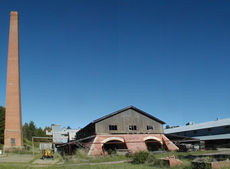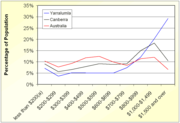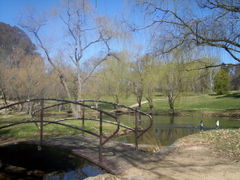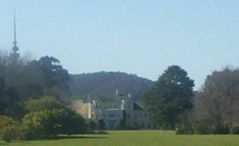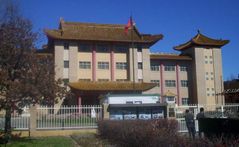Yarralumla, Australian Capital Territory
2007 Schools Wikipedia Selection. Related subjects: Geography of Oceania (Australasia)
| ' Canberra, Australian Capital Territory |
|||||||||||||
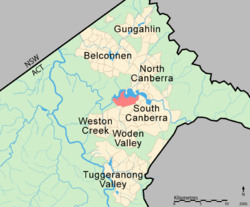 |
|||||||||||||
| Population: | 3026 (2001 census) | ||||||||||||
| Established: | 1928 | ||||||||||||
| Postcode: | 2600 | ||||||||||||
| Property Value: | AU$692,000 (2005) AUD | ||||||||||||
| District: | South Canberra | ||||||||||||
|
|||||||||||||
[[Category:1928 establishments|]][[Category:Suburbs of Canberra|]]
Yarralumla is a large suburb in the inner south of Canberra, the capital city of Australia. Located approximately 3.5 kilometres south-west of the city centre, Yarralumla extends for much of the southern bank of Lake Burley Griffin.
Europeans first settled in the area in 1828. It was officially named Yarralumla after the local Ngunnawal Indigenous Australian name for the area in 1834. Fredrick Campbell built a large homestead on his property in 1891 that now serves as Government House, the official residence of the Governor-General of Australia. The suburb was officially gazetted in 1928 and today is home to approximately 3000 people and many diplomatic missions. In recent years, it has become one of Canberra's most desirable and expensive suburbs because of its leafy streets, attractive lakeside setting and central location.
Geography
Yarralumla is located in the central Canberra district of South Canberra. It is bordered by Lake Burley Griffin to the north, Commonwealth Avenue and Capital Hill to the east, Adelaide Avenue and the Cotter Road to the south, and Scrivener Dam and part of the Molonglo River to the west.
Although Yarralumla is one of the largest suburbs in Canberra by area, its population remains quite small because more than half of its area consists of open space or non-residential developments. Yarralumla's open areas, Weston and Stirling Parks, the Royal Canberra Golf Club, the grounds of Government House and its proximity to the City and Lake Burley Griffin, are the main reasons for its growing popularity.
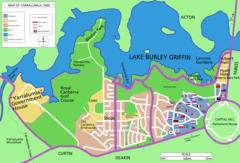
The embassy area of Yarralumla is located towards the eastern end of the suburb next to Stirling Park. It is the hilliest area of Yarralumla and was one of the most recent parts to be developed; Parliament House and the Parliamentary Triangle are located nearby.
The streets in Yarralumla are named after Australian governors and botanists. Most of the older streets in the suburb are laid out on a rectangular grid, while the more hilly eastern end of the suburb, including the embassy area, is set out with organic contour-guided roads. Major roads in Yarralumla include Banks Street, Novar Street and Hopetoun Circuit in a north-south direction and Schlich Street, Loftus Street and Weston Street running east-west. Being a dormitory suburb there are no major through roads. Access to the rest of the city can be made from Adelaide Avenue, Commonwealth Avenue, Lady Denman Drive and the Cotter Road, all of which run along the borders of the suburb.
Yarralumla is located on the Yarralumla Formation which is a mudstone/ siltstone formation that was formed around 425 million years ago during the Silurian Period. The formation extends from Red Hill and Woden in the South to Lake Burley Griffin in to the north, passing under the suburb of Yarralumla. The formation is evidence of the last major marine sedimentary period when eastern Australia was still covered by shallow seas. It shows fossil evidence of trilobites, coral and primitive crinoids. The Yarralumla brickworks quarry and the Deakin anticline are places where the formation is exposed and easily studied.
History
Settlement
The area now called Yarralumla is part of two original land grants, which were granted to free settlers for the establishment of farms. In 1828 Henry Donnison was granted an allotment on the western side of Stirling Ridge, while a second grant was made to William Klensendorlffe, who had bought the land from John Stephen, on 7 March 1839. Donnison's land was officially named Yarralumla in a survey of the area conducted in 1834. Yarralumla was a name for the area used by the local Ngunnawal people, apparently meaning "echo". Fredrick Campbell, a descendant of Robert Campbell, bought the property in 1881 and built a new three-storey house that would later form the basis of what is now the Governor General's residence Government House. Campbell also built a large woolshed nearby in 1904 that remains standing to this day.
In 1908, the Limestone Plains area, including Yarralumla, was selected as the site for the capital city of the newly-established Commonwealth of Australia. Soon afterwards in 1913, the Commonwealth Government purchased both properties. Tenant farmers were allowed to stay on the land on annual leases, some remaining until 1963 when the Molonglo River was dammed to form Lake Burley Griffin.
Development
With the construction of Australia's capital city underway, the Yarralumla brickworks were established in 1913 to supply building material. The bricks were used for many of Canberra's buildings, including the provisional Parliament House. In 1917 Walter Burley Griffin named the area surrounding the brickworks "Westridge". A Narrow gauge goods railway line was constructed for the transportation of bricks to some of the major building sites in central Canberra. This linked the brickworks to places like Parliament House, and the Kingston Power House.
Construction on the Commonwealth nursery and Westbourne Woods arboretum was started in 1914, and a temporary camp was built near the brickworks to accommodate the workers. Thomas Charles Weston was Officer-in-Charge (Afforestation Branch) in the years 1913 to 1926, and later became Director of City Planting and the Superintendent of Parks and Gardens. Weston was responsible for testing and selecting plant species at the arboretum for their suitability to Canberra's environment; from 1913 through to 1924 Weston oversaw the propagation of more than two million trees which were then planted in the Canberra area. Most of the original Westbourne Woods arboretum is now leased to the Royal Canberra Golf Club, with the remainder forming part of Weston Park. The Yarralumla nursery is still active, albeit on a smaller scale and functioning as a retail nursery selling both wholesale and direct to the public.
In 1922 A workers' tent camp was erected in the area on the eastern side of Stirling Ridge to house the men working on the main intercepting sewer. The following year saw the start of the construction of 62 small, four-room, unlined timber cottages, to be used as housing for the married tradesmen involved in the construction of the provisional Parliament House. Other camps were established at the eastern end of Stirling Park on the hills opposite modern Lotus Bay. The first of these was contractor John Howie's settlement (1922–30), consisting of 25 timber cottages for his married men and timber barracks (Hostel Camp) for his single men. Two other single mens' tent camps were established nearby – Old Tradesmen's Camp (1923–27) and No 1 Labourers Camp (1924–27). The men from Howie's worked on the Hotel Canberra and the others on the construction of the provisional Parliament House and nearby administrative buildings.
The Stirling Park camps were known as "Westlake" to their new inhabitants, and previously "Gura Bung Dhaura" (stony ground) to the local Aboriginal people. In 1925, the population of this temporary suburb was 700. This represented roughly one-fifth of the total population of the Federal Capital Territory at the time; in the region, only Molonglo Settlement had a larger population, at 750. The site was chosen so that it was near to Parliament House but hidden from direct line of sight from anywhere "important". The small cottages at Westlake were removed starting in the mid-1950s, with the last one removed in 1965. Many of the Westlake workers' cottages were moved to Queanbeyan and are still used as housing today. The Stirling Park near the embassy area of Yarralumla now covers the historic Westlake settlement area. Some evidence of these former dwellings still remains today, and signage has been erected to commemorate these pioneering people of early Canberra.
The Commonwealth Forestry School was established in Westridge near the brickworks and Westbourne Woods in 1926. It opened with its first intake of students in the following year. Today the heritage-listed Forestry School and the associated principal's residence Westridge House are located on Banks Street, Yarralumla. CSIRO Forestry and Forestry Products subsumed the school in 1975. Westridge House, an impressive tudor-style structure, recently underwent a $500,000 refurbishment and is presently in use as a residence for the chief officer of the CSIRO.
By 1928 there were over 130 people on the electoral roll for Westridge. The majority of the population consisted of men working at the brickworks and nursery. Westridge was officially gazetted as a Canberra suburb in 1928. Its residential area was situated adjacent to the proposed site for Lake Burley Griffin, close to Westbourne Woods and the 53- hectare grounds of the Governor-General's residence.
Post WWII
Westridge was officially renamed to Yarralumla in the 1950s. In 1963 Lake Burley Griffin was filled and Yarralumla was expanded to include Westlake, which had up until then been officially part of Acton.
After World War II, the suburb began to expand rapidly with the construction of many private homes. Yarralumla's image as a "lower-class" suburb would persist into the 1960s and 1970s. This general perception began to alter once Lake Burley Griffin had been created and its surrounds landscaped into parklands; the area soon gained a reputation for its attractive lakeside location. During the 1980s house prices began to rise co-incident with a rejuvenation of the suburb. Large numbers of the original government-built monocrete, brick and weatherboard houses have now been demolished and replaced by larger dwellings of a variety of more modern styles and materials. The suburb is generally regarded as one of the more desirable in Canberra.
Demographics
The population of the Westridge area on the 1928 electoral roll numbered over 130. On Census night 2001 Yarralumla had a population of 3026 people.
The 2001 Census shows that Yarralumla residents have a median age of 43, compared to a Canberra average of 32. Yarralumla is a comparatively wealthy suburb with 50% of the population earning over AU$1000 a week; this compares to a Canberra-wide figure of 29% and an Australia-wide figure of 18.6%. The 2001 Census figures put Yarralumla's unemployment rate at two percentage points below the Canberra average. In line with the Canberra average, the public service or defence force employed around 25% of the workforce. The median monthly housing loan repayments in Yarralumla were $1400–$1599, compared to the Canberra-wide figure of $800–$999. In 2005 Yarralumla's median house price was $692,000 versus $352,500 for the whole of Canberra.
The population of Yarralumla is predominantly Australian-born, with some 70.5% of its residents being born in Australia. The second most prevalent birthplace is the United Kingdom at 7.5%. The most popular religious affiliations in descending order are Catholic, no religion, Anglican, Uniting, Presbyterian and Buddhist. Accommodation is mostly separate houses, although the number of residences in the suburb has been increasing through conversion of blocks to dual occupancy and other medium-density-type developments.
Suburb amenities
The Yarralumla local shopping centre is located on the corner of Bentham and Novar Streets. The centre contains a supermarket, bakery, drycleaners, video store/post office, chemist and newsagent as well as several restaurants and speciality shops. The shopping area has undergone redevelopment in recent years, including the addition of a two-storey office development facing the shopping centre.
Yarralumla's first school, the Catholic St Peter Chanel's Primary School, opened in 1956; it later closed in the 1990s. Yarralumla Primary School, a public school, opened a year after St Peter Chanel's in 1957. Half of the original primary school is now used as a behavioural centre catering to problem students. There are two preschools in Yarralumla: Hill Corner Preschool, which is now the St Nicholas Greek-Australian Preschool; and the Montessori preschool, which is located in the former St Peter Chanel's Primary school buildings.
Weston Park is situated on a peninsula near the western end of Lake Burley Griffin. The park includes swimming areas, children's play equipment and wading pools, and is a popular barbeque spot on weekends. Weston Park forms part of a string of parks that line southern shore of Lake Burley Griffin; other parks include Yarralumla Bay, Lennox Gardens and Stirling Park.
Like most of Canberra, Yarralumla's only scheduled public transport is provided by ACTION buses. Three bus routes run through Yarralumla. Bus numbers 31, 32 and 84 all run an identical route through the suburb via Novar Street, Schlich Street and Hopetoun Circuit. Buses 31 and 32 run from Woden Town Centre to Civic, while bus 84 runs from Woden to Manuka and Kingston. Generally, ACTION bus routes run every 30 to 60 minutes from 7 a.m. to 11:30 p.m.
Politics
|
|
||||||||||||||||||||||||||||||
Yarralumla is located within the federal electorate of Canberra. Annette Ellis currently (2005) represents the electorate of Canberra in the House of Representatives. Historically both federal electorates in the ACT are safe Labor seats. Polling place statistics are shown to the right for the Yarralumla polling place in the 2004 federal and ACT elections.
In the ACT Legislative Assembly, Yarralumla is part of the electorate of Molonglo, which elects seven members on the basis of proportional representation. The 2004 ACT election saw a swing of 7.3% towards the Labor Party and 4.1% away from the Liberal Party.
The Yarralumla Residents Association (YRA) is a registered organisation formed to represent the views of Yarralumla residents and business. The group stands against government plans for "urban consolidation", supporting open space and the conservation of low-density housing. The organisation has been very vocal in opposing government plans for further development of Yarralumla and is also vocal about any plans for the Yarralumla Brickworks site.
Notable places
Yarralumla is notable among Canberra suburbs for its large number of landmarks and places of historical interest. The Governor-General's residence Government House, which shares the name Yarralumla, is located at the western end of the suburb in 53 hectares of parkland. It sits alongside Lake Burley Griffin, next to the Royal Canberra Golf Club and Scrivener Dam. The house was built in 1891 as the homestead for the Yarralumla property. The nearby Yarralumla Woolshed is available for event hire, often playing host to parties and bush dances. The land surrounding the woolshed has been developed as an equestrian park, including areas for showjumping, eventing and endurance riding.
The Yarralumla brickworks are notable as the first industrial manufacturing facility in the ACT. The brickworks were closed temporarily several times due to the Great Depression and both World Wars. They closed permanently in 1976 after plans for major modernisation upgrades were not proceeded with. Presently the site is closed to the public and is in a state of disrepair. The unfenced parkland around the brickworks is a popular recreation area for Yarralumla residents. Future plans for the site have not yet been decided.
The eastern end of Yarralumla is home to many of the diplomatic missions in Canberra, many of which are built in a traditional style reflecting that of their respective home countries. Examples of regionally-styled chanceries include the embassies of Saudi Arabia, Thailand and China, and the High Commissions of India and Papua New Guinea. The United States embassy was the first embassy built in Canberra, with the foundation stone laid on the fourth of July, 1942. The embassy is an impressive compound of buildings built in a Georgian style, inspired by several buildings designed by Christopher Wren for Virginia at the beginning of the 18th century. Canberra tourist drive six takes tourists on a car-based tour past many of Canberra's embassies including those located in Yarralumla.
Also located in the eastern end of the suburb are Lennox Gardens, the Yarralumla Yacht Club, the Albert Hall and the Hotel Canberra. The Hotel Canberra opened in 1924 to accommodate politicians when Parliament was in session. The hotel was closed in 1974 and the buildings served as an annexe for Parliament House between 1976 and 1984. The Hyatt Hotel Group re-opened the hotel in 1987.
| Embassies and High Commissions in Yarralumla | |||||
|---|---|---|---|---|---|


